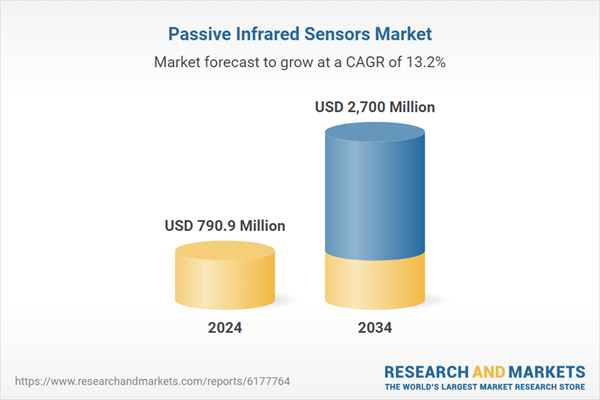The increasing popularity of smart home automation is one of the key factors driving this growth. As consumers invest more in connected devices, the demand for PIR sensors has surged, as these sensors are essential for enabling motion detection in smart lighting systems, security alarms, and HVAC (heating, ventilation, and air conditioning) applications. PIR sensors, known for their low power consumption and reliable motion-detection capabilities, are becoming integral to enhance convenience, security, and energy efficiency. The rise of voice assistants and IoT devices further expands the use of PIR sensors in multifunctional devices that offer seamless automation. Additionally, the global emphasis on sustainability and energy efficiency has promoted the adoption of PIR sensors in energy-saving building solutions. These sensors help optimize the control of lighting, heating, and cooling systems by detecting human presence and reducing unnecessary energy use. This trend is particularly important as governments implement stricter energy efficiency regulations and companies adopt green building certifications.
The motion controller segment held a 41.2% share and was valued at USD 326 million in 2024. Motion controllers continue to dominate the PIR sensor market due to their crucial role in security systems, lighting control, and energy management solutions. Their affordability, low power usage, and easy integration make them essential in residential, commercial, and industrial applications.
The long-wave PIR sensor segment generated USD 382.3 million in 2024. Long-wave PIR sensors are in high demand for outdoor and large-area applications, such as perimeter security, military surveillance, traffic monitoring, and smart city infrastructure. The growing focus on advanced security systems, public safety, and defense modernization is driving this segment’s expansion. Companies looking to maintain leadership in the market should prioritize the development of long-range sensors with enhanced connectivity, reduced false alarms, and higher performance to cater to large-scale infrastructure and defense projects.
United States Passive Infrared Sensors Market generated USD 245.8 million in 2024, with a CAGR of 14% fueled by a surge in home automation, the increasing demand for advanced security systems, and a rise in smart infrastructure projects. The adoption of smart homes, a heightened focus on energy efficiency, and government incentives promoting sustainable building practices are all accelerating the use of PIR sensors in various sectors. Additionally, the strong U.S. defense and aerospace industries contribute to the growing demand for high-performance PIR sensors used in surveillance and monitoring applications.
Key players operating in the Global Passive Infrared Sensors Market include General Dynamics Corporation, Bosch Security Systems, LLC, Honeywell International Inc., Cypress Semiconductor, Elmos Semiconductor, Axis Communications AB, STMicroelectronics N.V., Panasonic Holdings Corporation, Excelitas Technologies Corp., Atmel Corporation, Murata Manufacturing Co., Ltd., Hamamatsu Photonics K.K., Ningbo Sanhe Sensor Co., Ltd., Espon Toyocom Corporation, and Nippon Avionics Co., Ltd. Companies in the Passive Infrared Sensors Market are employing several key strategies to solidify their market position. These strategies include investing in the development of innovative sensor technologies, focusing on improving sensor performance, and enhancing energy efficiency. Firms are also expanding their product portfolios to meet the growing demand for advanced PIR sensors, especially in applications such as smart homes, security, and energy management. Another important strategy is forming strategic partnerships and collaborations to access new markets and share technological expertise.
Comprehensive Market Analysis and Forecast
- Industry trends, key growth drivers, challenges, future opportunities, and regulatory landscape
- Competitive landscape with Porter’s Five Forces and PESTEL analysis
- Market size, segmentation, and regional forecasts
- In-depth company profiles, business strategies, financial insights, and SWOT analysis
This product will be delivered within 2-4 business days.
Table of Contents
Companies Mentioned
The companies profiled in this Passive Infrared Sensors market report include:- Atmel Corporation
- Axis Communications AB
- Bosch Security Systems, LLC
- Current Corporation
- Cypress Semiconductor
- Elmos Semiconductor
- Epson Toyocom Corporation
- Excelitas Technologies Corp.
- General Dynamics Corporation
- Hamamatsu Photonics K.K.
- Honeywell International Inc.
- Murata Manufacturing Co., Ltd.
- Ningbo Sanhe Sensor Co., Ltd.
- Nippon Avionics Co., Ltd
- Panasonic Holdings Corporation
- STMicroelectronics N.V
Table Information
| Report Attribute | Details |
|---|---|
| No. of Pages | 190 |
| Published | September 2025 |
| Forecast Period | 2024 - 2034 |
| Estimated Market Value ( USD | $ 790.9 Million |
| Forecasted Market Value ( USD | $ 2700 Million |
| Compound Annual Growth Rate | 13.2% |
| Regions Covered | Global |
| No. of Companies Mentioned | 17 |









